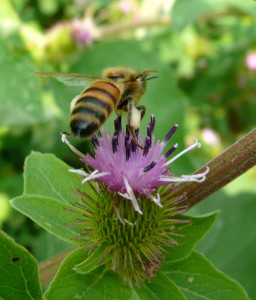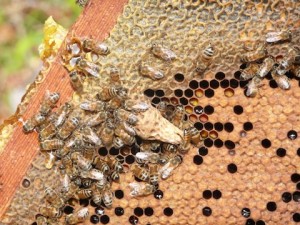Live from the Hive: August 2014

“Burdock, an essential plant” by Annie Watson, Thistle Hill Studio
The crickets are singing nonstop…We’ll be heading to Addison County Field Days, Vermont’s big agricultural fair, this week…Blackberries are ripe. Most days are still very warm, but there’s a chill in the air of an evening. Summer is winding down.
For honey bees, the next six weeks are crucial, for they must make enough honey to see the colony through next winter. That’s why burdock, now flowering, is so important. In Vermont in August, it’s the bees’ major food source.
If you allow a hedgerow of burdock and other “weeds” such as jewelweed and mustard to grow along borders of your property, you are providing food not only for honey bees but for all manner of pollinators. If the burdock is growing where you don’t want it to (like at the edge of my vegetable garden!), you can watch it and cut it down just after the flowers have begun to dry up but before the seeds have fully formed. That way you can still guard against those pesky burs while allowing the bees a food critical to their survival. It’s really important that we maintain burdock in Vermont! For more about burdock, which is also a very medicinal plant, click here.
 “The Making of a Queen” by Annie Watson,
“The Making of a Queen” by Annie Watson, 